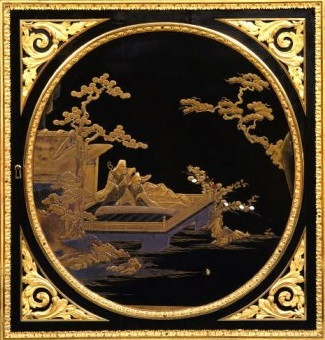
POIRIER Simon Philippe (EN)
Biographical Article
Simon Philippe, born around 1720, was the son of Simon Poirier, a marchand-mercier, and Anne-Marguerite Levesque. His parents ran a shop in rue des Fossés-Saint-Germain-l'Auxerrois, and his mother's family belonged to a dynasty of goldsmiths. His father participated in 1724 in the valuation of the property of the deceased Philippe d'Orléans (1674-1723), regent of the kingdom of France (AN, Xia 9166). His brother, François Alexandre, was also a marchand-mercier, and the family also included two sisters, Anne Madeleine and Françoise Anne.
His family background was strongly rooted in Parisian trade and, more particularly, that of the marchand-merciers, as evidenced by the signatures of his parents and merchant friends on his marriage contract (AN, MC, ET/CXVII/756). Simon Philippe was still a minor when he married on November 9, 1742. He then lived in rue Saint-Honoré, parish of Saint-Germain-l'Auxerrois, with his uncle, the marchand-mercier Thomas Joachim Hébert (1687-1773). His young wife Marguerite Madeleine was the daughter of the marchand-mercier Michel Hécéguère (circa 1723-1753). Simon Philippe Poirier joined his father-in-law and the guild of marchand-merciers, and he moved in with his in-laws on rue Saint-Honoré, "À la Couronne d'Or". In the middle of the 18th century, this district, in the immediate vicinity of the Louvre, was an essential place for the trade in luxury items, and other competing brands of important merchants had shops there: Lazare Duvaux (circa 1703-1758), Julliot, Dulac, and Bazin.
When Michel Hécéguère died in June 1753, Simon Philippe Poirier took over the activity of the À Couronne d'Or. Five years before the sale of his business in April 1777, he decided to partner with his cousin by marriage, Dominique Daguerre (circa 1740-1796). Simon Philippe Poirier died, likely childless, on August 29, 1785, in the rue de l'Éperon, parish of Saint-André-des-Arts (AN, MC, ET/CXVIII/627); his wife outlived him by a few years.

The Collection
According to the agreement made during his association with his father-in-law, the merchant Michel Hécéguère, Simon Philippe Poirier shared half of the profits of the business. Poirier was the sole manager of the shop from 1753 and continued to offer his customers a substantial choice among veneered or varnished wood furniture, bronzes, Chinese and Japanese lacquerware, porcelain from Saxony, Chantilly, Vincennes-Sèvres, and the Far East. The À la Couronne d’Or brand became the most important store in Paris in terms of the quality and rareness of the pieces sold. In 1772, he was cited in the Tablettes royales de renommée: "Poirier, rue St Honoré, opposite the Hôtel d'Aligre, holds one of the most superb shops of porcelain, mirrors, arms, chandeliers, gilded lights, cabinetmaking and curiosities.” His reputation enabled him to develop a considerable clientele in Paris and abroad.
To produce luxury furniture, he employed top cabinetmakers such as Bernard II Van Risen Burgh (B.V.R.B.) (circa 1700-1766), Joseph Baumhauer (?-1772), Vandercruse dit La Croix Senior (1728-1799), and Martin Carlin (circa 1730-1785). Having become one of the major customers of the Manufacture royale de porcelaine de Sèvres and its main retailer in Paris, he had the idea of ordering porcelain specially made to be embellished with gilt bronze and plates to garnish certain pieces of furniture, of which he obtained a quasi-monopoly as of 1758. Small tables or chests of drawers with porcelain tops quickly gave way to more sophisticated furniture: chests of drawers, secretaries, bonheurs-du-jour, jewellery boxes, writing desks, and clocks. Poirier did not neglect the sale of important lacquer furniture, most often with Japanese panels, as evidenced by the delivery in 1766 of a majestic chest of drawers intended for the Marquis de Marigny (1727-1781) for the sum of 4,000 pounds (private collection).
Poirier achieved a notoriety that attracted the greatest buyers to his home: the royal family, including the Count of Provence, the Count and Countess of Artois, the Duchess of Villeroy, the Prince of Condé, the Marshal of Soubise, the Marshal de Mirepoix, the Count of Cobenzl or even the royal administration of Menus-Plaisirs on the occasion of special ceremonies. In 1770, Colonel de Saint-Paul, an English diplomat stationed in Paris, noted in his address book: "Poirier, rue Saint-Honoré always has a very good choice but very expensive", which did not prevent certain Britons to obtain supplies directly from him, such as George William Earl of Coventry (1722-1809) and Horace Walpole (1717-1797) in the 1760s. He also played an important role in posthumous inventories and contributed to the drafting of several sales catalogs at auctions, including that of the 1769 sale of Louis Jean Gaignat (1697-1768).
One of Poirier's major clients was Louise Jeanne Durfort de Duras, Duchess of Mazarin (1735-1781), who, for the decoration of her hotel particulier, procured a quantity of pieces in Sèvres porcelain, mounted pieces of oriental porcelain, lacquers, and various pieces of furniture made of wood. Some of his purchases were also intended as gifts to honour his family and close friends.
The last favourite of Louis XV, Jeanne Bécu, Comtesse du Barry (1743-1793), was also one of Poirier's best clients. At his home, between 1768 and 1774, she spent nearly 100,000 pounds on superb lacquer chests of drawers, including those made with the collaboration of cabinetmaker Martin Carlin, now in the Fine Arts Museums of San Francisco (Legion of Honor, 1931.145). She bought a large number of pieces of Sèvres porcelain, vase fittings, chandeliers, and various bronze furnishings that she places in Versailles or in her property in Louveciennes.
While he largely contributed to furnishing the cabinets of the great amateurs of Chinese or Japanese pieces, the posthumous inventory of Simon Philippe Poirier, drawn up in 1785 (AN, MC, ET/CXVIII/627), mentions no collection of Asian art, nor any stock of goods at his home. He retired definitively from his trade in 1777 and was replaced by marchand-mercier Dominique Daguerre (circa 1740-1796), one of his relatives.
Related articles
Personne / personne

